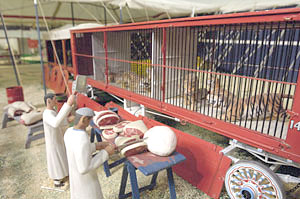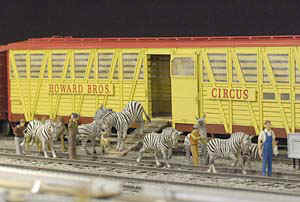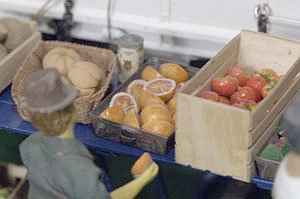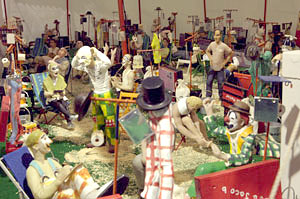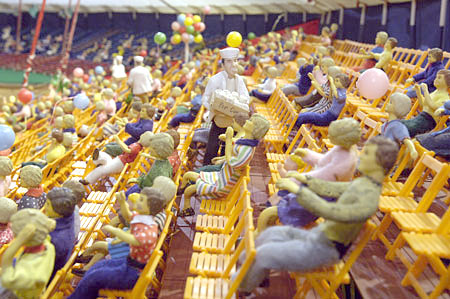Ringmaster of his own designThe circus comes to town every day for Howard C. Tibbals, the creative genius behind an intricate miniature world.By LENNIE BENNETT, St. Pete Times art critic
SARASOTA - Howard C. Tibbals dreams as big as John Ringling ever did. Only the scale of his dreams is small. Tibbals, 69, has spent 50 years building a miniature circus that is considered the largest of its kind in the world, spending his own money to create it, though he says he has lost track of how much it has cost over the years. It sprawls across almost 4,000 square feet, an astonishing achievement in detail and verisimilitude. It has found a permanent home in a new, $6.5-million building that Tibbals has donated to the John and Mable Ringling Museum of Art. It opens Jan. 14, the first phase of a $76-million museum expansion. The 30,000-square-foot Tibbals Learning Center will contain changing exhibitions of vintage circus posters from the donor's collection of about 5,000 and vintage and contemporary costumes, some given by Cirque du Soleil. It also will have a large time line of the history of the circus and interactive displays for children. But its grand centerpiece is the Howard Bros. Circus, an exact replica of a Ringling Bros. and Barnum & Bailey Circus as it would have been during the "Golden Age" of the circus in the 1920s and 1930s. (Tibbals was refused permission to use the Ringling Bros. and Barnum & Bailey name; he says he is now glad because painting the alternate name on all the wagons was much easier.) Portions of it have been exhibited in other venues but it has never been seen in its entirety. This is no child's play, though children will love it. So will adults; I was mesmerized for a good hour and could have stayed longer. Its scale is three-quarters of an inch to 1 foot and consists of more than 42,000 pieces, most hand-carved. This 3-D slice of life captures the drama and vastness of the circus enterprise in its heyday, as well as the wonder and excitement it generated when the trains rolled into towns across America. Visitors will enter the Tibbals Learning Center through a tent, into a double-story atrium lined with red velvet panels. Overhead hang trapeze wires and nets. The circus display, which occupies the first floor of the center, is set in Knoxville, Tenn., Tibbals' hometown (he and his wife now divide their time between homes in Tennessee and Sarasota). A corridor takes you along a city street scene, including his family's original business, Tibbals Flooring. Opposite the skyline, circus cars wait to be unloaded on tracks that have been laid with 33,000 hand-carved wooden spikes. Adults and children watch as zebras and camels disembark. Draft horses pull wagons hauling canvas and poles to a grassy field where a tent city has risen. The field represents 20 acres where eight major tents, including the Big Top, and numerous smaller ones are pitched. We first see it as the circus employees do, from the staging areas near the tracks. The mess tent is full of bustle as cooks flip pancakes. A small video screen positioned inside the tent, one of several throughout the display, shows documentary footage of circus cooks making breakfast. Several hundred workers sit at long tables eating, or stand up and stretch, argue or laugh. Tibbals' wife, Janice, positioned every piece of food on 900 plates with a pair of tweezers. A dapper John Ringling stands outside his tent, cigar in hand, dog at his side, overseeing operations. Behind him, elephants and the "spectacle" floats process toward the Big Top. The acrobats' rehearsal is interrupted when one falls off the wire. She lies in a mound of sawdust as men approach with a stretcher. Those small moments, everywhere you look, enrich the experience beyond its marvel as a grand feat of craftsmanship. Tibbals researched every detail, using a 1936 Root Book - the circus version of a high school yearbook. Look beside each woman preparing for her act, and you see a metal bucket of water and a trunk. They are lettered with the name and number of real people, including the late Charlotte Shive Maxwell, a St. Petersburg Realtor who in her youth joined the circus and performed in it for years before settling down. The display is circular, so you wind your way closer to the Big Top, past the public parking lot loaded with authentic automobiles of the period and a running trolley car, and then approach the Midway where crowds are forming. Hawkers sell live chameleons, Cracker Jack and Frozen Delight. The ticket wagon alone took Tibbals a year to build. Peek past the ticket seller and you can dimly make out the cash register. Tibbals filled it with miniature currency and coins, built slots along the wagon wall for tickets, included a typewriter and adding machine, details no one can see that the collector wanted anyway. The show is in progress under the Big Top, and spectators watch from chairs and bleachers. The seven acts on the floor, along with high-wire acts, clowns and various entertaining distractions, simultaneously perform. Most figures are stationary but some acrobats twirl overhead, and camels and horses revolve around one ring. The lighting in the Big Top simulates the passing of a day, timed to go from daylight to dark every seven minutes. Outside the Big Top, kids are being collared by a policeman for trying to peek beneath the canvas. One is running away. You leave the tents behind and head toward a covered bridge where a last bit of drama waits. A renegade elephant is frolicking in the river while a desperate trainer tries to coax it ashore. Tibbals' fascination with the circus, which he says began as a young boy, has become a magnificent obsession. When he started it half a century ago, he began with bolts of white muslin and a used sewing machine to make the Big Top. It took him 18 years to finish it, while he worked on other components. He carved the earliest figures himself, but soon hired a master carver to shape each animal and most of the humans, no two poses alike. Every item can, and has been, packed into the accompanying railroad cars. Tibbals says it will never be finished. And to prove it, he will have a workshop at the center with a glass wall so visitors can see him working on yet another tweak on the display. The only bit of inauthenticity he allowed is the inclusion of a couple in the middle of the crowd. They're kissing. And they're Howard and Janice Tibbals. Clearly a labor of love. FUN FACTS - The Howard Bros. Circus is built on a scale of three-quarters of an inch to 1 foot. - It contains 42,143 items, not including small pieces such as thousands of railroad stakes. - It consists of eight large tents, 152 circus wagons, 1,500 workers and performers, 7,000 folding chairs and more than 500 hand-carved animals. - Everything can be packed up into the 55 train cars, also individually hand-crafted. - The display includes seven miniature video stations positioned in various tents with documentary footage of circus life from the 1920s and 1930s. - The Tibbals Learning Center will have revolving displays of original circus posters, some very rare, from Howard C. Tibbals' collection of almost 5,000, and vintage photographs from his collection of about 1-million. - Also on display will be a miniature circus street parade with 38 wagons and about 900 performers and hand-carved animals built by Tibbals' mentor, Harold Dunn, which Tibbals purchased after Dunn's death.
|
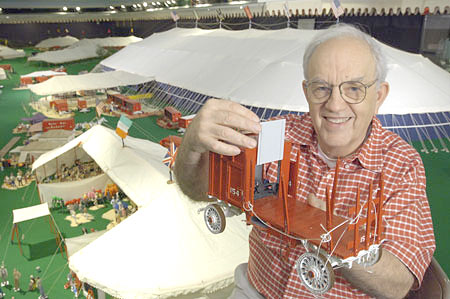
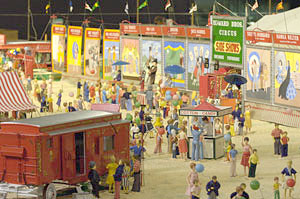
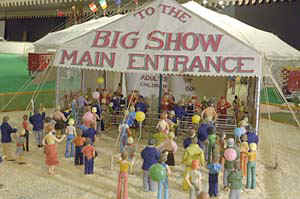
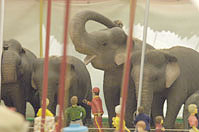 Dozens of
hand-carved elephants, each striking a different pose, perform in the Menagerie Tent,
above.
Dozens of
hand-carved elephants, each striking a different pose, perform in the Menagerie Tent,
above. 